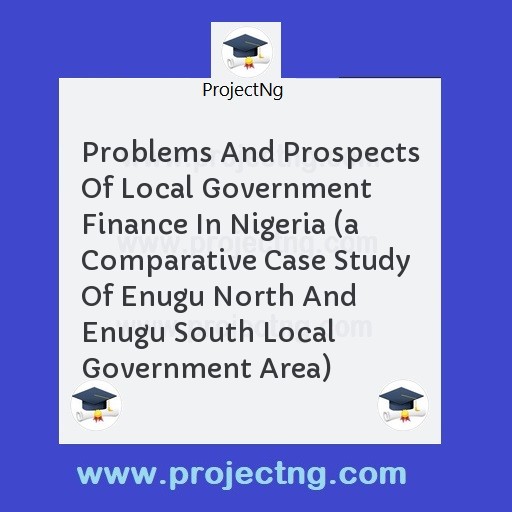Problems And Prospects Of Local Government Finance In Nigeria (a Comparative Case Study Of Enugu North And Enugu South Local Government Area)
Accounting Project Topics
Get the Complete Project Materials Now! »
PROBLEMS AND PROSPECTS OF LOCAL GOVERNMENT FINANCE IN NIGERIA (A COMPARATIVE CASE STUDY OF ENUGU NORTH AND ENUGU SOUTH LOCAL GOVERNMENT AREA)
ABSTRACT
This research study is based on the problems and prospects of local government finance in Nigeria; it is a comparatively study of Enugu North and Enugu South Local Government of Enugu State. The study is divided into give chapters, each focusing on particular aspect of the subject.
Chapter one covers the general introduction to the subject. Statement of problems, statement of objectives, test of hypothesis, significance of study, limitation and scope of the study, and finally the definition of operational terms used in this study.
In the second chapter, relevant literature on the subject are reviewed. The review covers areas like: functions of local government, statutory basis of local government finance, local government expenditure patter and management and control of local government finance.
Chapter three deals with the research methodology used by the researcher for the study.
In chapter four, it concerns itself with the analysis and presentation of relevant data collected for the research work.
Finally, in chapter five, it deals with summary of findings, recommendations and conclusions.
Here, the researcher explores the various problems of local government finance and made suggestions with respect to ways improving the existing revenue sources and brings to light potential sources of revenue available to the local governments.
TABLE OF CONTENTS
Cover page
Title page - - - - - - - - - -
Certification page
Dedication
Acknowledgement
Abstract
Table of contents
CHAPTER ONE
1.0 Introduction
1.1 Statement of the study
1.2 Objectives of study
1.3 Significance of the study
1.4 Statement of hypothesis
1.5 Scope and limitation of the study
1.6 Definition of terms
CHAPTER TWO
2.0 Review of related literature
2.1 Introduction
2.2 Functions of local government
2.3 Statutory base of local government finance in Nigeria
2.4 Sources of local government revenue
2.5 Local government expenditure pattern
2.6 Management and control of local government finance
CHAPTER THREE
3.0 Research design and methodology
3.1 Sources of data
3.2 Population definition
3.3 Population sample
3.4 Statistical treatment of data & problems of data collection
CHAPTER FOUR
4.0 Data presentation and analysis
4.1 Analysis of data
4.2 Testing of hypothesis
CHAPTER FIVE
5.0 Summary of findings, conclusion and recommendation
5.1 Summary of findings
5.2 Conclusion
5.3 Recommendations
Bibliography
Appendix
CHAPTER ONE
1.0 INTRODUCTION
A local government is the third tier of government in Nigeria. Like any level of government, it has administrative structure, statutory assigned functions, social commitment and financial arrangement necessary for it to maintain itself and perform its statutory function to its citizens.
Local Government Authority in Nigeria was legally recognized for the first time, as the third tier of level of government by the 1979. Constitution of the Federal Republic of Nigeria; section 7 (1) and decree N0. 12, the constitution of the Federal Republic of Nigeria, 1989 that spells its functions. Since 1979, there has been a tremendous growth in local government expenditure in line with greater emphasis on grassroots participation. For instance, in 1992 while complete political, administrative and financial autonomy was granted to the local government from state control, its responsibility was enlarged. In addition to the functions assigned to it by the constitution the local government is now (with effect from 1992) directly responsible for primary and adult education, primary health care and rural water supply. Faced with these increased responsibilities and the enormous expenditure associated with them, it is pertinent that the local government expands its sources of revenue beyond the present level.
An action in this direction is necessary, as it would enable the local government to discharge its current functions and bring socio-economic development to the local populace.
Before now, the local government relied heavily on grants from the state and federal government relied heavily on grants from the federation account 20% in addition to a percentage of the internally generated funds of the state.
Before now the amount granted by the local government was very small. In the face of the complete independence now enjoyed by the local government. It is statutory required that it relies more on funds generated internally for the performance of its functions.
This being the case, government grants and statutory allocations are only supplementary sources of revenue to the local governments. For the local government to be self-sustaining financially, without reducing the level and quality of its services to the people, it is important that it reaches out for potential internal revenue sources which would supplement existing ones. This
Be the First to Share On Social

Enjoying our content?
Don't miss out on new videos! Subscribe to our YouTube channel for more awesome content.
Subscribe Now!













